
Long-range observation at night has long been a problem for military, police, security personnel and coast guard observations and for protection of industrial and nuclear power plants.
Image intensification systems have been around for many years but had limited range and identification problems. This technology was improved through the introduction of CCD cameras with active near infrared illumination but range still remains a problem. More recent developments have seen the more widespread introduction of thermal imaging (infrared) technology, this in recent years having become more acceptable with the availability of imaging arrays of up to full TV quality. Although infrared will work equally well day or night the image is formed using either the 3 to 5 or 8 to 12 micron atmospheric spectral windows and as the wavelengths are not visible very experienced observers are required for image interpretation. In general the performance of CCTV systems at night depends strongly on good illumination from perimeter and other lights.
Through the years
During the 1990s a research institute in Canada developed a patented high power laser diode array called DALIS (diode array laser illumination system) and the first unit was delivered in 1994 for use in a Canadian defence product. The encouraging results prompted researchers to begin work during 1996 on ground-based active imaging applications which could meet needs unmet by conventional technologies including thermal imagers, active and passive intensified cameras.
The first prototype system was unveiled in 2001 and the success of this saw the establishment of Obzerv Technologies in March 2002, the company receiving 7 million Canadian dollars in private financing from another listed Canadian company, Extreme CCTV in 2003. Current customers using the launch product include the US Navy, the French Army, Germany and the Royal Canadian Mounted Police (RCMP).
The night vision systems developed and under development by Obzerv are based on two core technologies, range gating and the DALIS illuminator. (Note that the DALIS illuminator provides the best performance for long range imagery.) Existing laser systems lack sufficient power and beam uniformity while the use of laser diodes provides an illumination beam free of laser speckle. Range gating technology combines two key components, the pulsed laser beam from the DALIS, and a specially designed camera intensifier that can open and close at very high speeds (in the order of tens of nanoseconds). No ambient illumination (moonlight for example) is required for optimum operation of the system. In effect a laser pulse is emitted at time t0, is reflected by the target at time t1, and at time t2, determined by the range and the depth of field required by the camera is opened for a short period.
The Flagship product offered by Obzerv is its ATV-2000i surveillance system which offers a total day/night capability. For night time operation the camera uses the DALIS laser illuminator operating at 860 nm and optional accessories include a geo-reference option. This option includes a GPS, an electronic compass, an invilometer and a laser rangefinder. A range-gated intensified CCD camera (based on a tube from a European manufacturer) with a resolution of 640 x 480 pixels is used as the detector. The optics used is a zoom system with an objective lens aperture of 200 mm and f numbers between 5 and 20 (depending on zoom selection). The magnification range is 45 to 180 while the focal length of the lens is variable from 1 to 4 metres, providing a field of view between 4,5 and 18 mrad. Video recording is possible in either PAL or NTSC format.
The ATV-2000i uses a touch-screen computer console to present the video and other data to the observer. The user interface has been carefully designed to fully exploit the capabilities of active imaging while keeping the burden on the operator to a minimum so that he can concentrate on the observation task. The graphic user interface implements sliders to adjust brightness, zoom position and the focus. A horizontal slider at the bottom of the display is used to adjust the position of the range gate and its depth. Diagnostic screens can also be called up at the touch of a button.
For less demanding day operation a colour CCD camera (2 Lux minimum illumination) with its own optical channel is used with a 26x zoom lens operating at between f/1.6 and f/3.8. Because of the available light the field of view is much larger and ranges between 30 to more than 700 mrad. Horizontal resolution in PAL operating mode is 460 TV lines. In both day and night operation the operator console communicates with the sensor head through a standard TCP/IP network which will operate up to 90 m away without the use of repeaters. Standard wireless video transmission equipment can also be used to relay the video signal to remote monitors.
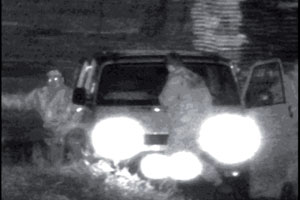
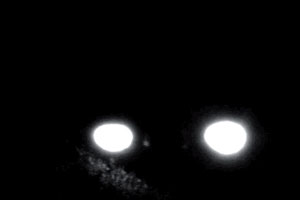
So what is unique about the ATV-2000i and its range-gating operation? Some general performance figures are pertinent here. Designed for long range night operation the system can read a vehicle number plate at a distance of up to 2 km (thermal imagers can not read numbers or names as there is no thermal contrast with the surroundings), recognise a human being (as opposed to an animal) at up to 5 km, classify a vehicle at 10 km and pinpoint people in search and rescue operations at distances greater than 10 km. While normal intensified devices 'bloom' under strong direct light this does not affect range-gated devices and car number plates for example can be read even when the vehicle is facing the camera with the headlights full on. Parasitic light is further reduced using a narrow band filter centred on the laser wavelength. Again the system will operate effectively in very bad weather conditions including rain, fog and the snowfalls found in North America. The 860 nm radiation (unlike the longer wavelengths used by thermal imaging devices) will penetrate glass and it is possible to observe individuals seated within cars, helicopters or in the wheelhouse of a ship. This would also apply to seeing through the windows of a building in, for example, a hostage situation. The problem of active lighting, which causes blooming and/or produces shadows is obviated. Unlike thermal imagers (which make use of the thermal radiation generated by a human, ship or vehicle and transmitted in the 3 to 5 or 8 to 14 micron spectral bands) the image produced by the gated technology looks normal while the thermal image of a strange object requires special skills. Different types of vehicle for example would have a different heat profile determined by such things as the engine, exhaust system, wheels or tracks, and their location.
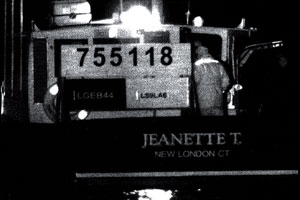
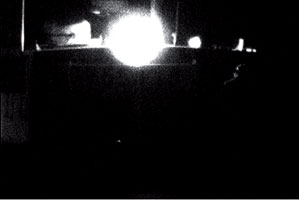
In terms of real range capabilities those familiar with the well-established Johnson criteria (detection requires one resolvable cycle and recognition four cycles over the object) will find the following table extremely pertinent. These figures are based on the Johnson criteria with a conservative target contrast of 30%, a probability of 90% and a standard atmospheric visibility of 15 km (again conservative for South Africa at night.) The figures apply to zero ambient illumination, in other words no active lighting and a totally overcast sky.
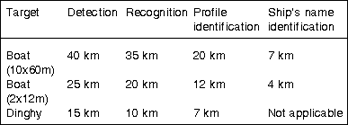
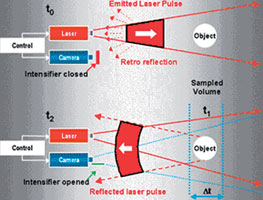
So what are the applications of the Obzerv range of products? They are certainly not intended to replace the limited range devices currently being installed in various CBDs or the perimeters of small buildings. The ATV-2000i comes into its own where long distance surveillance is required. Obvious users are the military (the 860 nm wavelength defeats most forms of camouflage netting), security personnel, search and rescue services and the coast guard/navy, where the identity (name) of vessels can be clearly observed under both good and poor visibility. Use could also be made of the system to detect illegal fishing activities, now of critical importance for South Africa. The system also comes into its own where key points have a long perimeter that has to be kept under surveillance. This would include airports, country borders, diamond mines, large industrial companies, military bases, oil refineries, oil platforms and even nuclear power plants.

© Technews Publishing (Pty) Ltd. | All Rights Reserved.